CFD-Based Fire Risk Assessment and Control at the Historic Dong Wind and Rain Bridges in the Western Hunan Region: The Case of Huilong Bridge
Abstract
:1. Introduction
2. Methodology
2.1. Field Survey
2.1.1. Features and Structures of a Dong Wind and Rain Bridge
2.1.2. Moisture Content of Wind and Rain Bridge Materials
2.1.3. Traditions, Activities, and Ceremonies Involving Fire
2.1.4. Fire Loads of Wind and Rain Bridges
2.2. Software Simulations
2.2.1. Simulation Model
- Cylindrical columns were replaced with square columns of the same volume.
- All combustible materials were assumed to be involved in the burning and were completely burned.
- For determining the heat release rate of wood combustion, the moisture content of the wood was considered, but heat loss due to vaporization was not considered.
2.2.2. Simulation Parameters
- 1.
- Point of origin and size of the fire
- 2.
- Slice and measurement point parameters
2.2.3. Conditions for Flashover
2.3. Mitigation Strategies
3. Results and Discussion
3.1. Survey Result
3.1.1. Features and Structure of Dong Wind and Rain Bridges
3.1.2. Moisture Content of the Construction Materials Used for Wind and Rain Bridges
3.1.3. Traditions, Activities, and Ceremonies Involving Fire
- 1.
- Fire cultural practices performed on wind and rain bridges
- 2.
- Fire cultural practices of the Dong people
3.1.4. Fire Loads of Wind and Rain Bridges
3.2. Simulation Results
3.2.1. Spread of Fire
3.2.2. Variations in the Parameters at Each Measurement Point
4. Mitigation Strategies
4.1. Flashover Ignition Time and Fire Optimization Enhancement Factor P
4.2. Combustion Parameters for Different Mitigation Strategies
5. Conclusions
- The results of the survey revealed that historic Dong wind and rain bridges are at risk of serious fires. Wood is the main building material used in wind and rain bridges, and the wood has been exposed to the wind and sun for a long time and has an average moisture content of 11%, which makes it highly prone to fire accidents. The fire habits of the Dong people (i.e., fire pits, sacrificial activities, and other fire-related customs held at the wind and rain bridges) increase the fire risk. The typical fire load of a wind and rain bridge is 1,794,561 MJ, and in case of fire, the surrounding forests and wooden dwellings are likely to be engulfed in fire, resulting in a serious fire accident.
- The simulation results showed that the historic Huilong bridge in the Hunan region is vulnerable to fire damage. After a fire, the central pavilion underwent a flashover at 200 s. By 600 s, the maximum temperature of the bridge was 1200 °C, and the entire bridge was in flashover condition. The high-temperature smoke spread upward, and the wooden-framed roof of the bridge was found to be highly vulnerable to damage by fire. Because the wind and rain bridge is far from the village, it is difficult for local residents to find it in time for rescue, which will cause serious or even irreparable damage to the historical bridge.
- Four fire-mitigation strategies were proposed by considering the characteristics of the storm bridges: automatic fire-extinguishing equipment, fireproof coating, skylights, and suspended ceilings. The mitigation strategies were verified by simulation. The order of effectiveness of the mitigation strategies was as follows: fireproof coating > automatic fire-extinguishing equipment > suspended ceiling > skylight. We recommend prioritizing the use of a fireproof coating to enhance the fire resistance of the wind and rain bridges without causing damage to the traditional features. Automatic fire-extinguishing equipment and skylight measures can also reduce the fire risk of the storm bridges; however, the effect is not as good as that of fireproof coating. Ceiling measures are not recommended because they increase the fire risk of the wind and rain bridges.
Author Contributions
Funding
Institutional Review Board Statement
Informed Consent Statement
Data Availability Statement
Acknowledgments
Conflicts of Interest
Appendix A


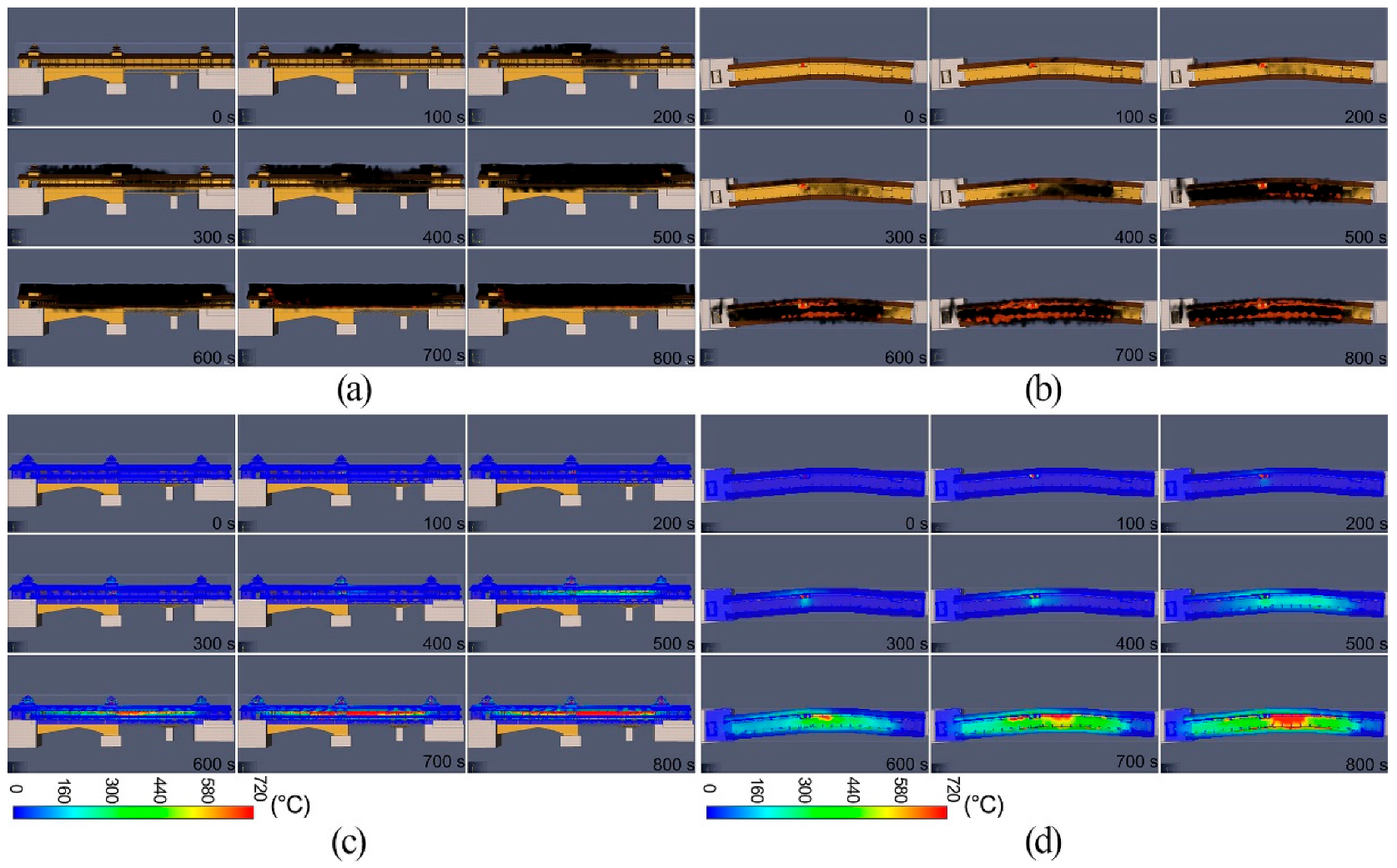
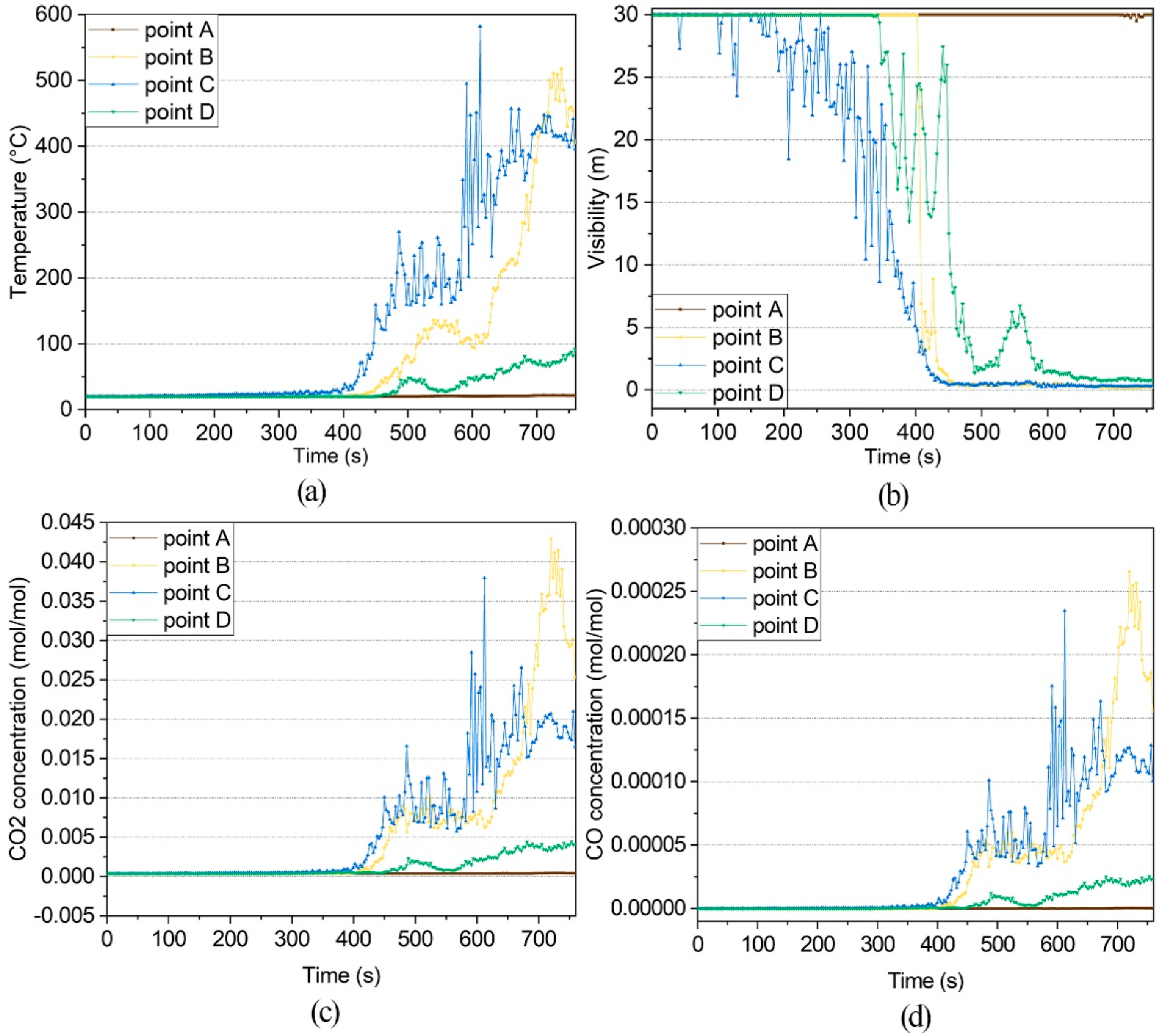
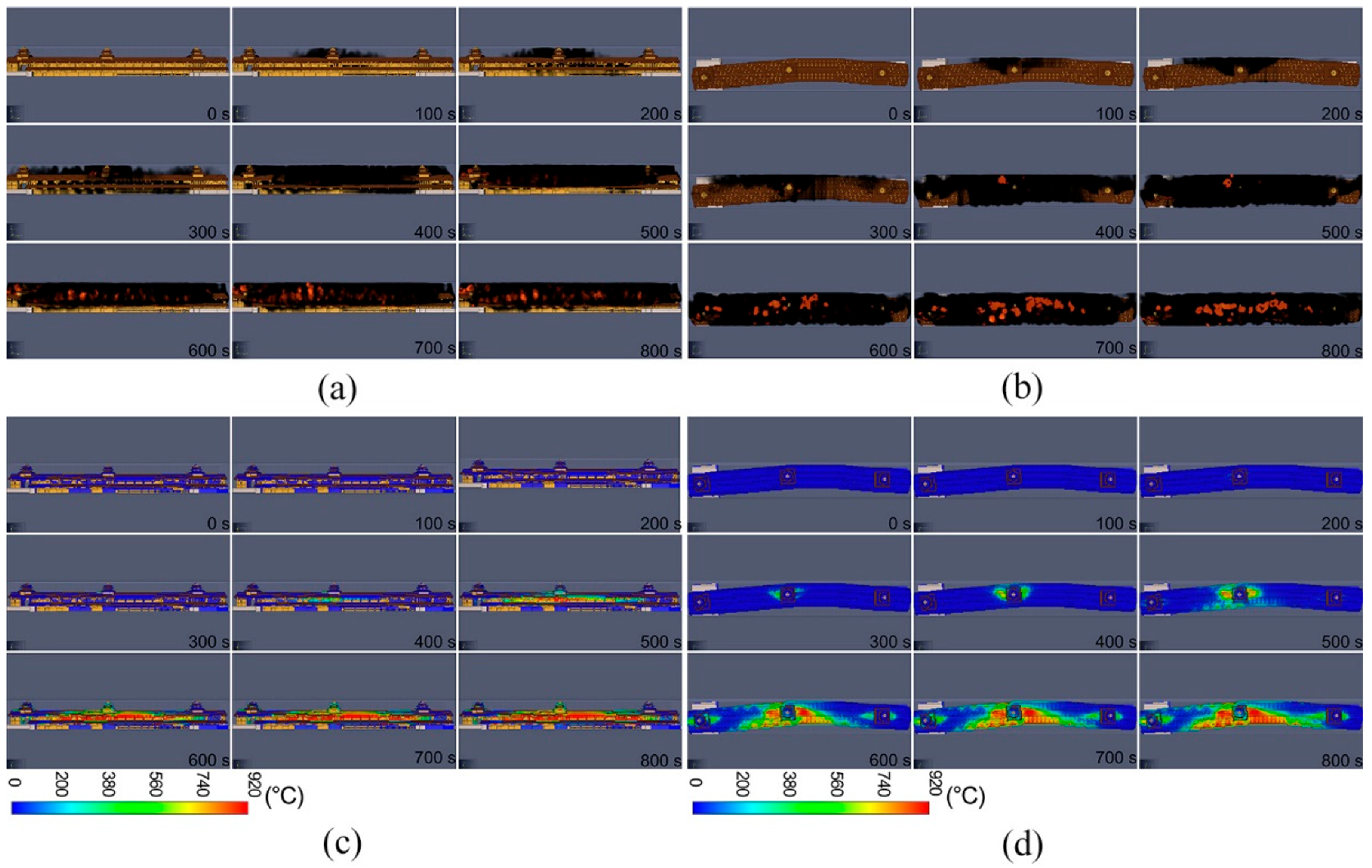

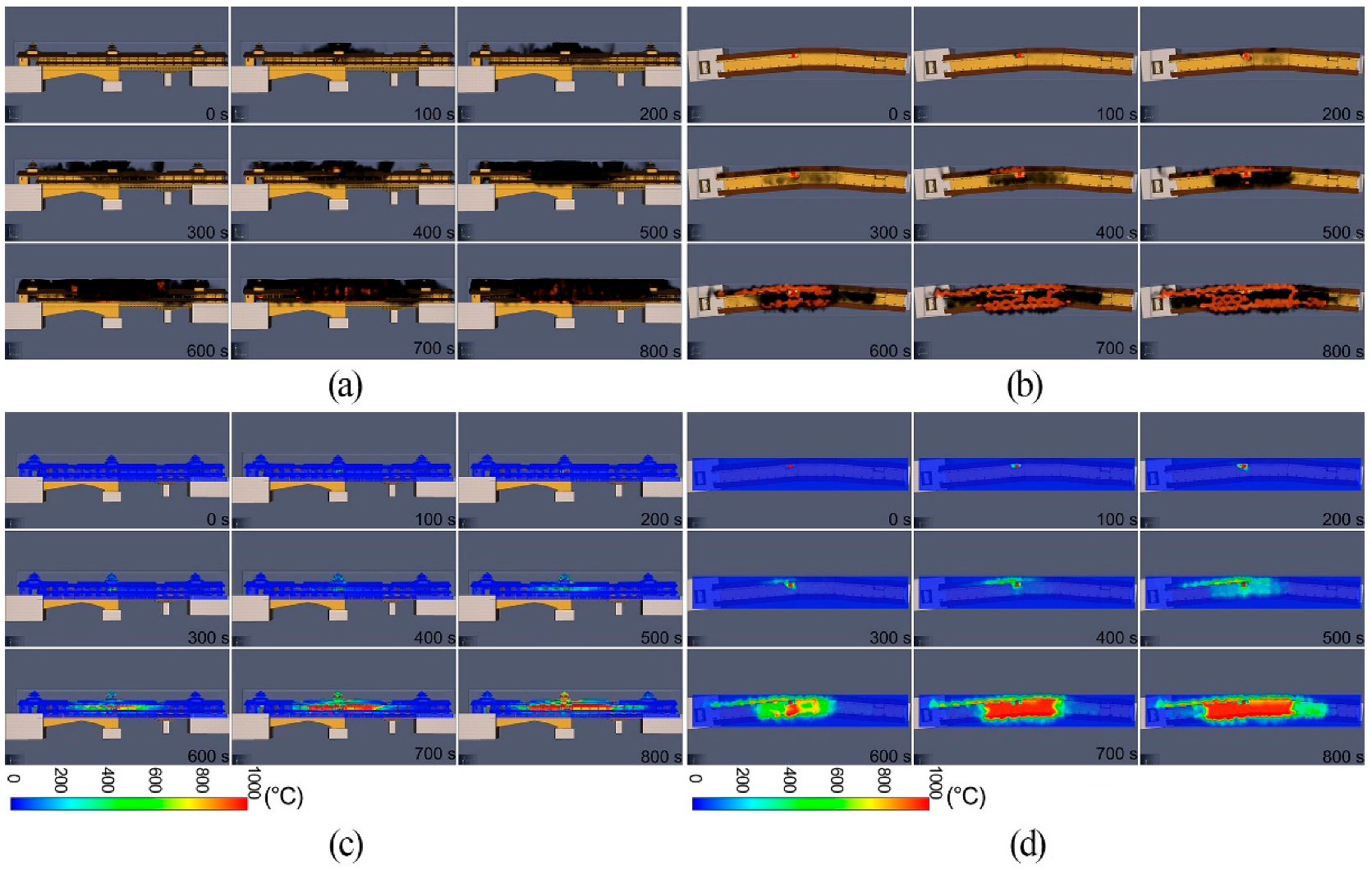

References
- Etinay, N.; Egbu, C.; Murray, V. Building urban resilience for disaster risk management and disaster risk reduction. Procedia Eng. 2018, 212, 575–582. [Google Scholar] [CrossRef]
- Mısırlısoy, D.; Günçe, K. Adaptive reuse strategies for heritage buildings: A holistic approach. Sust. Cities Soc. 2016, 26, 91–98. [Google Scholar] [CrossRef]
- Al-Sakkaf, A.; Zayed, T.; Bagchi, A. A sustainability based framework for evaluating the heritage buildings. Int. J. Energy Optim. Eng. 2020, 9, 49–73. [Google Scholar] [CrossRef]
- Shan, M.; Chen, Y.F.; Zhai, Z.; Du, J. Investigating the critical issues in the conservation of heritage building: The case of China. J. Build. Eng. 2022, 51, 104319. [Google Scholar] [CrossRef]
- Salazar, L.G.F.; Romão, X.; Paupério, E. Review of vulnerability indicators for fire risk assessment in cultural heritage. Int. J. Disaster Risk Reduct. 2021, 60, 102286. [Google Scholar] [CrossRef]
- Chorlton, B.; Gales, J. Fire performance of heritage and contemporary timber encapsulation materials. J. Build. Eng. 2020, 29, 101181. [Google Scholar] [CrossRef]
- Ferreira, T.M. Notre Dame Cathedral: Another case in a growing list of heritage landmarks destroyed by fire. Fire 2019, 2, 20. [Google Scholar] [CrossRef]
- Marrion, C.E. More effectively addressing fire/disaster challenges to protect our cultural heritage. J. Cult. Herit. 2016, 20, 746–749. [Google Scholar] [CrossRef]
- Durak, S.; Erbil, Y.; Akıncıtürk, N. Sustainability of an architectural heritage site in Turkey: Fire risk assessment in Misi village. Int. J. Arch. Herit. 2011, 5, 334–348. [Google Scholar] [CrossRef]
- Shabani, A.; Kioumarsi, M.; Plevris, V.; Stamatopoulos, H. Structural vulnerability assessment of heritage timber buildings: A methodological proposal. Forests 2020, 11, 881. [Google Scholar] [CrossRef]
- Zhou, B.; Zhou, X.; Chao, M. Fire protection of historic buildings: A case study of Group-living Yard in Tianjin. J. Cult. Herit. 2012, 13, 389–396. [Google Scholar] [CrossRef]
- Jones, P.B.; Li, X. What can a bridge be? The wind and rain bridges of the Dong. J. Arch. 2008, 13, 565–584. [Google Scholar] [CrossRef]
- Lu, X.; Wei, Y.; Hu, X.; Fang, J. A Study on the Architecture Culture of The Wind and Rain Bridge—A Case Study of Huilong Bridge in Tongdao County. IOP Conf. Ser. Earth Environ. Sci. 2020, 474, 072068. [Google Scholar] [CrossRef]
- National Bureau of Statistics of China. China Fire Protection Yearbook; China Personnel Press: Kuala Lumpur, Malaysia, 2014; pp. 51–55. [Google Scholar]
- Sohu.com. The Wanan Bridge, the longest surviving wooden arch corridor bridge in China, burned down. Available online: https://www.sohu.com/a/580827134_121095667 (accessed on 30 August 2022).
- Hegazi, Y.S.; Tahoon, D.; Abdel-Fattah, N.A.; El-Alfi, M.F. Socio-spatial vulnerability assessment of heritage buildings through using space syntax. Heliyon 2022, 8, e09133. [Google Scholar] [CrossRef]
- Huang, H.; Li, L.; Gu, Y. Assessing the accessibility to fire hazards in preserving historical towns: Case studies in suburban Shanghai, China. Front. Archit. Res. 2022, 11, 731–746. [Google Scholar] [CrossRef]
- Clementi, F.; Gazzani, V.; Poiani, M.; Lenci, S. Assessment of seismic behaviour of heritage masonry buildings using numerical modelling. J. Build. Eng. 2016, 8, 29–47. [Google Scholar] [CrossRef]
- Nadkarni, R.R.; Puthuvayi, B. A comprehensive literature review of Multi-Criteria Decision Making methods in heritage buildings. J. Build. Eng. 2020, 32, 101814. [Google Scholar] [CrossRef]
- Yuan, C.; He, Y.; Feng, Y.; Wang, P. Fire hazards in heritage villages: A case study on Dangjia Village in China. Int. J. Disaster Risk Reduct. 2018, 28, 748–757. [Google Scholar] [CrossRef]
- Romão, X.; Bertolin, C. Risk protection for cultural heritage and historic centres: Current knowledge and further research needs. Int. J. Disaster Risk Reduct. 2022, 67, 102652. [Google Scholar] [CrossRef]
- Ibrahim, M.; Abdul Hamid, K.; Ibrahim, M.; Mohd Din, A.; Yunus, R.M.; Yahya, M. The development of fire risk assessment method for heritage building. Procedia Eng. 2011, 20, 317–324. [Google Scholar] [CrossRef] [Green Version]
- Naziris, I.A.; Lagaros, N.D.; Papaioannou, K. Optimized fire protection of cultural heritage structures based on the analytic hierarchy process. J. Build. Eng. 2016, 8, 292–304. [Google Scholar] [CrossRef]
- Huai, C.; Xie, J.; Liu, F.; Du, J.; Chow, D.H.; Liu, J. Experimental and Numerical Analysis of Fire Risk in Historic Chinese Temples: A Case in Beijing. Int. J. Arch. Herit. 2021, 1–15. [Google Scholar] [CrossRef]
- Arborea, A.; Mossa, G.; Cucurachi, G. Preventive fire risk assessment of Italian architectural heritage: An index based approach. Key Eng. Mater. 2015, 628, 27–33. [Google Scholar] [CrossRef]
- Ibrahim, M.; Ibrahim, M.; Mohd-Din, A.; Abdul-Hamid, K.; Yunus, R.; Yahya, M. Fire risk assessment of heritage building–perspectives of regulatory authority, restorer and building stakeholder. Procedia Eng. 2011, 20, 325–328. [Google Scholar] [CrossRef]
- Mydin, M.O.; Sani, N.M.; Abas, N.; Khaw, Y. Evaluation of Fire Hazard and Safety Management of Heritage Buildings in Georgetown, Penang. MATEC Web Conf. 2014, 10, 06003. [Google Scholar]
- Granda, S.; Ferreira, T.M. Large-scale vulnerability and fire risk assessment of the historic centre of Quito, Ecuador. Int. J. Arch. Herit. 2021, 15, 1043–1057. [Google Scholar] [CrossRef]
- He, Y.; Park, L.A. A statistical analysis of occurrence and association between structural fire hazards in heritage housing. Fire Saf. J. 2017, 90, 169–180. [Google Scholar] [CrossRef]
- Cao, Y.; Luo, C.; Liu, Y.; Teng, S.; Xin, G. Path intelligent optimization for dense crowd emergency evacuation in heritage buildings. J. Cult. Herit. 2021, 47, 180–187. [Google Scholar] [CrossRef]
- Huang, Y.H. The use of parallel computing to accelerate fire simulations for cultural heritage buildings. Sustainability 2020, 12, 10005. [Google Scholar] [CrossRef]
- Malomo, D.; DeJong, M.J. Post-fire collapse assessment of the bank buildings (Belfast, UK) masonry façade via discrete element macro-analysis. Structures 2022, 35, 1002–1009. [Google Scholar] [CrossRef]
- Wang, L.; Li, W.; Feng, W.; Yang, R. Fire risk assessment for building operation and maintenance based on BIM technology. Build. Environ. 2021, 205, 108188. [Google Scholar] [CrossRef]
- Tung, S.F.; Su, H.C.; Tzeng, C.T.; Lai, C.M. Experimental and numerical investigation of a room fire in a wooden-frame historical building. Int. J. Arch. Herit. 2020, 14, 106–118. [Google Scholar] [CrossRef]
- Xu, Z.; Zhang, Z.; Lu, X.; Zeng, X.; Guan, H. Post-earthquake fire simulation considering overall seismic damage of sprinkler systems based on BIM and FEMA P-58. Autom. Constr. 2018, 90, 9–22. [Google Scholar] [CrossRef]
- Wang, Y.; Gu, X.; Xia, L.; Pan, Y.; Ni, Y.; Wang, S.; Zhou, W. Hazard analysis on LPG fireball of road tanker BLEVE based on CFD simulation. J. Loss Prev. Process Ind. 2020, 68, 104319. [Google Scholar] [CrossRef]
- Xu, Z.; Wei, W.; Jin, W.; Xue, Q. Virtual drill for indoor fire evacuations considering occupant physical collisions. Autom. Constr. 2020, 109, 102999. [Google Scholar] [CrossRef]
- Sun, Q.; Turkan, Y. A BIM-based simulation framework for fire safety management and investigation of the critical factors affecting human evacuation performance. Adv. Eng. Inform. 2020, 44, 101093. [Google Scholar] [CrossRef]
- Baalisampang, T.; Saliba, E.; Salehi, F.; Garaniya, V.; Chen, L. Optimisation of smoke extraction system in fire scenarios using CFD modelling. Process Saf. Environ. Prot. 2021, 149, 508–517. [Google Scholar] [CrossRef]
- Wang, N.; Gao, Y.; Li, C.; Gai, W. Integrated agent-based simulation and evacuation risk-assessment model for underground building fire: A case study. J. Build. Eng. 2021, 40, 102609. [Google Scholar] [CrossRef]
- Zhang, F.; Shi, L.; Liu, S.; Shi, J.; Zhang, J. CFD-based framework for fire risk assessment of contiguous wood-frame villages in the western Hunan region. J. Build. Eng. 2022, 54, 104607. [Google Scholar] [CrossRef]
- Luo, L.; Wu, Y.; He, X.; Qin, W. Analysis of building materials for wind and rain bridge. AIP Conf. Proc. 2019, 2154, 020050. [Google Scholar]
- Li, X.; Li, W.; Smith, K.S.; Smith, A.C. Hidden from the wind and enjoying the water (藏风得水): The traditional cosmology of fengshui and the shaping of Dong villages in Southwestern China. Landsc. Res. 2018, 44, 614–627. [Google Scholar] [CrossRef]
- Chan, E.Y.Y.; Lam, H.C.Y.; Chung, P.P.W.; Huang, Z.; Yung, T.K.C.; Ling, K.W.K.; Chan, G.K.W.; Chiu, C.P. Risk perception and knowledge in fire risk reduction in a dong minority Rural Village in China: A health-EDRM education intervention study. Int. J. Disaster Risk Reduct. 2018, 9, 306–318. [Google Scholar] [CrossRef] [Green Version]
- Hong, Y. Architectural Characteristics of Enshi Wind-Rain Bridge. Appl. Mech. Mater. 2013, 368, 1450–1453. [Google Scholar] [CrossRef]
- Knapp, R.G.; Miller, T.E.; Liu, J. China’s corridor bridges: Heritage buildings over water. Built Herit. 2020, 4, 10. [Google Scholar] [CrossRef]
- Ministry of Natural Resources of the People’s Republic of China. National Geographic Information Public Service Platform. Available online: https://www.tianditu.gov.cn/ (accessed on 30 August 2022).
- Zhang, F.; Shi, L.; Liu, S.; Shi, J.; Ma, Q.; Zhang, J. Climate Adaptability Based on Indoor Physical Environment of Traditional Dwelling in North Dong Areas, China. Sustainability 2022, 14, 850. [Google Scholar] [CrossRef]
- GB 51249:2017; Code for Fire Safety of Steel Structures in Buildings. Ministry of Housing and Urban-Rural Development of the People’s Republic of China, China Plan Press: Beijing, China, 2018.
- Xu, L.; Zheng, W.; Xu, F. Case research on kitchen fire under water spray effect via numerical simulation. Case Stud. Therm. Eng. 2022, 31, 101772. [Google Scholar] [CrossRef]
- Cai, N.; Chow, W. Numerical studies on heat release rate in a room fire burning wood and liquid fuel. Build. Simul. 2014, 7, 511–524. [Google Scholar] [CrossRef]
- Džolev, I.; Laban, M.; Draganić, S. Survey based fire load assessment and impact analysis of fire load increment on fire development in contemporary dwellings. Saf. Sci. 2021, 135, 105094. [Google Scholar] [CrossRef]
- Li, J.; Li, H.; Zhou, B.; Wang, X.; Zhang, H. Investigation and statistical analysis of fire loads of 83 historic buildings in Beijing. Int. J. Arch. Herit. 2018, 14, 471–482. [Google Scholar] [CrossRef]
- Cheng, H.; Hadjisophocleous, G.V. Dynamic modeling of fire spread in building. Fire Saf. J. 2011, 46, 211–224. [Google Scholar] [CrossRef]
- Chow, C.; Chow, W.K. Heat release rate of accidental fire in a supertall building residential flat. Build. Environ. 2010, 45, 1632–1640. [Google Scholar] [CrossRef]
- Kolaitis, D.I.; Asimakopoulou, E.K.; Founti, M.A. Fire protection of light and massive timber elements using gypsum plasterboards and wood based panels: A large-scale compartment fire test. Constr. Build. Mater. 2014, 73, 163–170. [Google Scholar] [CrossRef]
- Buchanan, A.H.; Dunn, A.; O’Neill, J.; Pau, D.J.W. Fire safety of CLT buildings in New Zealand and Australia. Wood Fiber Sci. 2018, 50, 96–101. [Google Scholar] [CrossRef]
- Walls, R.; Zweig, P. Towards sustainable slums: Understanding fire engineering in informal settlements. In Proceedings of the International Conference on Sustainable Vital Technologies in Engineering and Informatics, Cairo, Egypt, 7–9 November 2017; pp. 93–98. [Google Scholar]
- Xu, L.; Zheng, W. Numerical simulation on the influence of low air pressure upon smoke spread and fire alarm process. Case Stud. Therm. Eng. 2021, 26, 101004. [Google Scholar] [CrossRef]

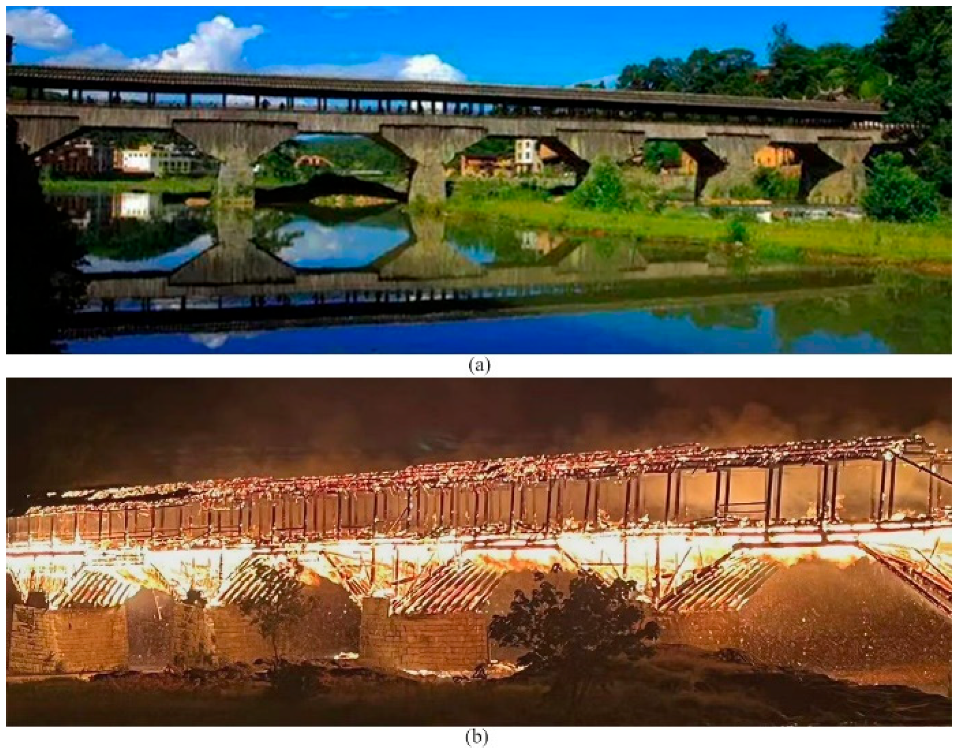
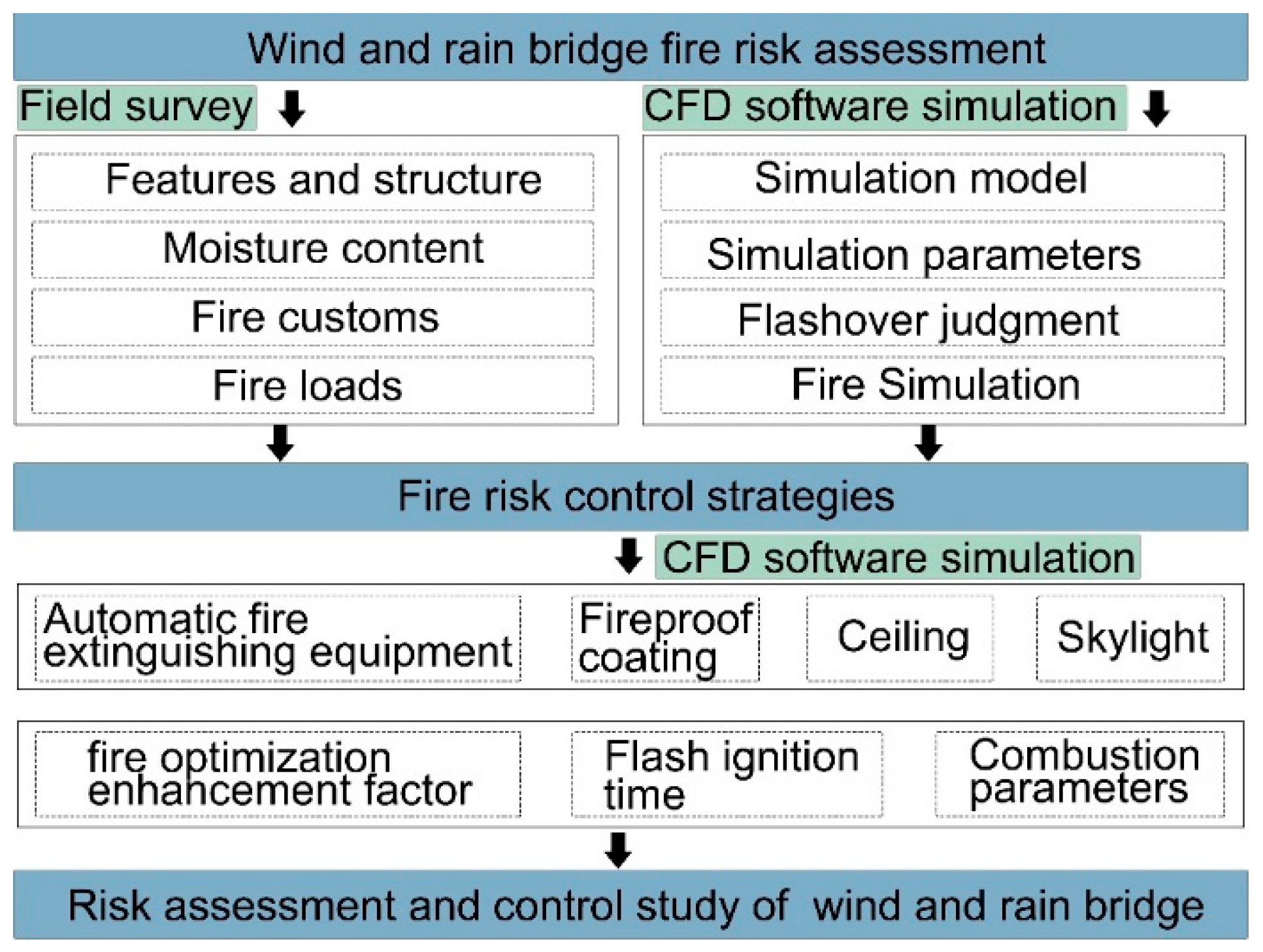

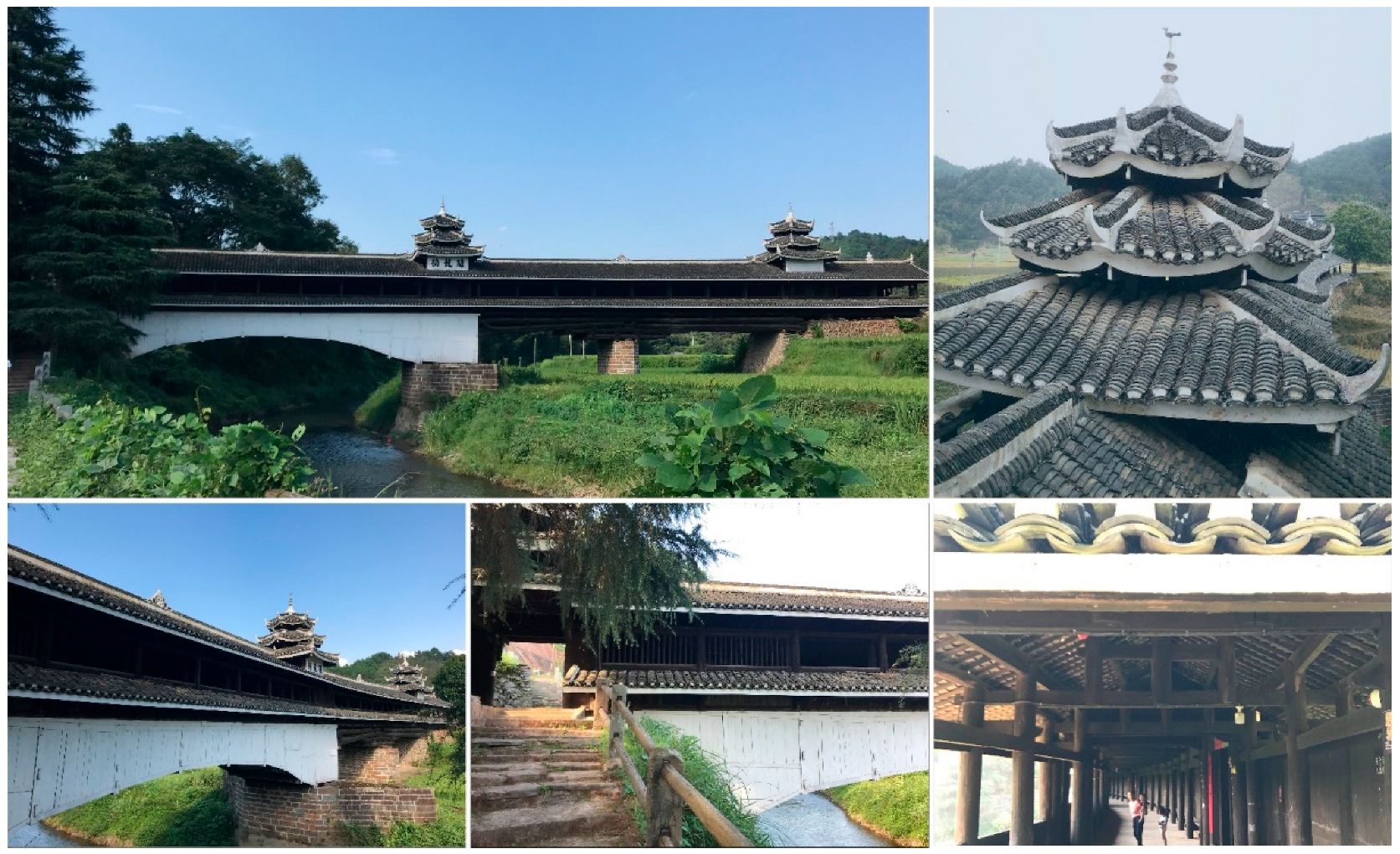

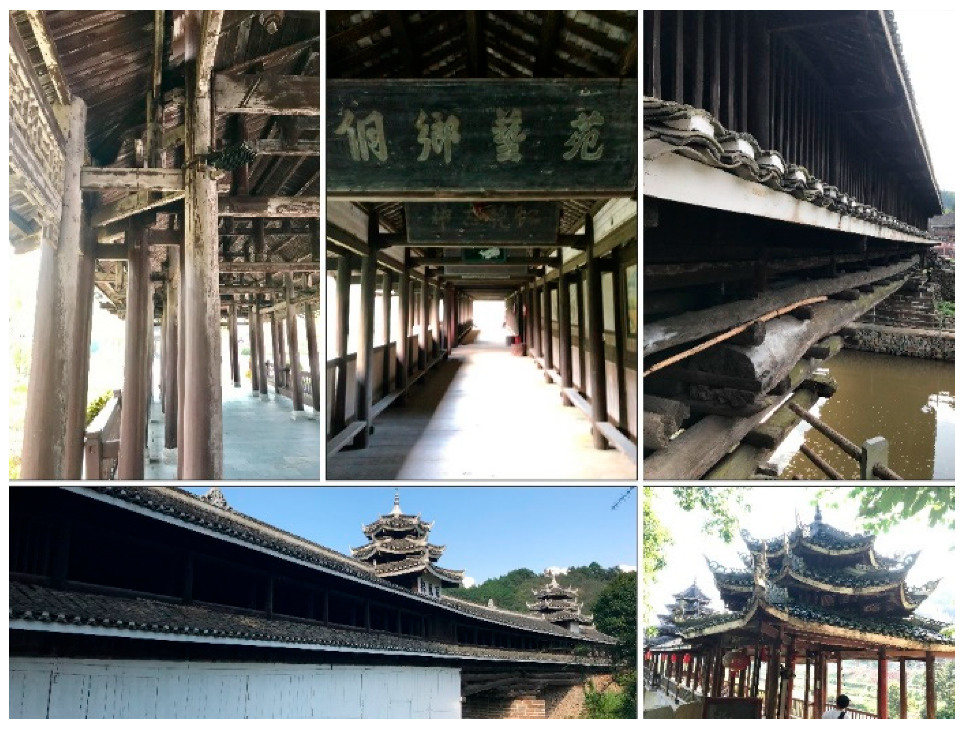


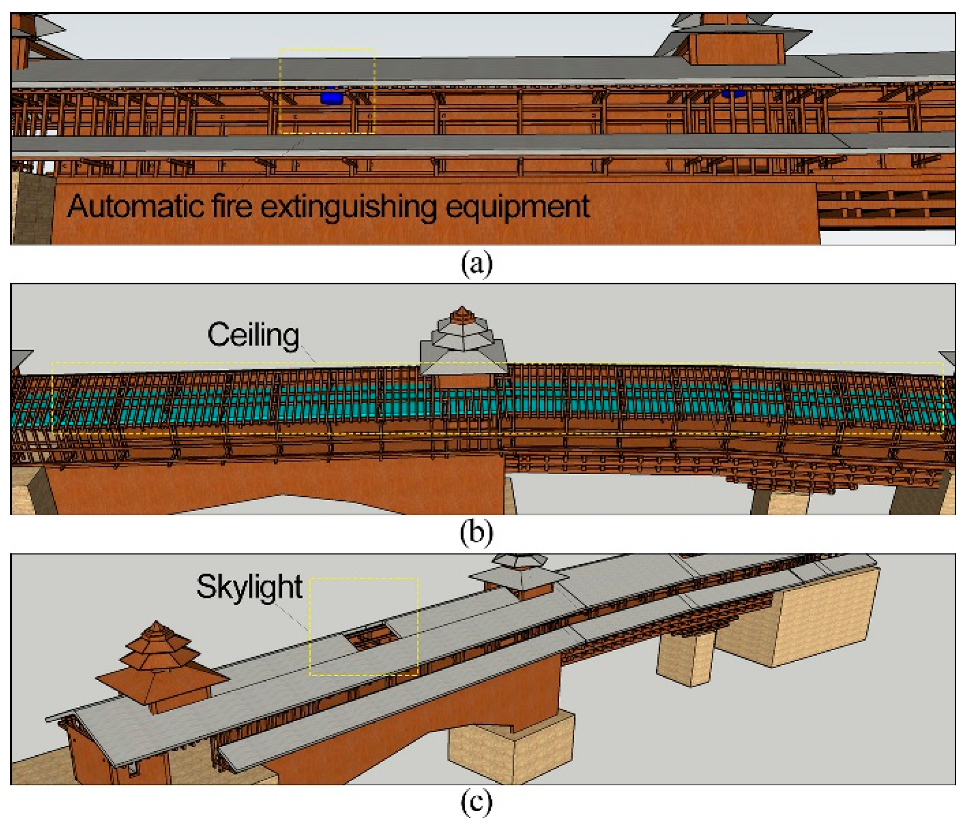


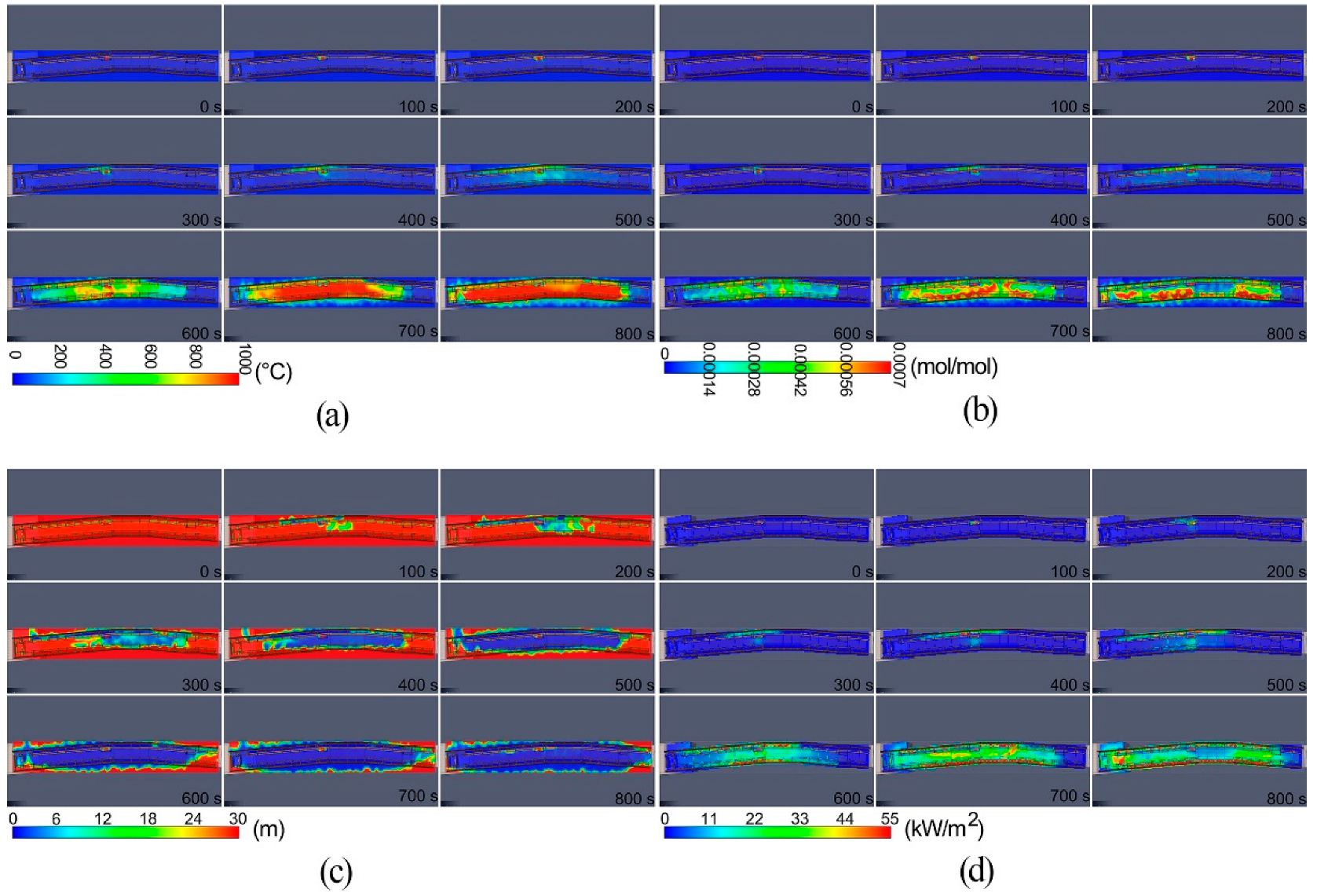


| Material | Density kg/m3 | Specific Heat Capacity kJ/(kg·K) | Thermal Conductivity W/(m·K) |
|---|---|---|---|
| Fireproof glass | 2500 | 0.84 | 0.75 |
| Fireproof board | 1086 | 0.8 | 0.109 |
| Fireproof coating | 634 | 0.9 | 0.167 |
| Material | Density kg/m3 | Specific Heat Capacity kJ/(kg·K) | Thermal Conductivity W/(m·K) |
|---|---|---|---|
| Fir wood | 500 | 2.52 | 0.108 |
| Small green tile | 2800 | 0.92 | 0.76 |
| Fireproof curtain | 38.3 | 3.528 | 0.125 |
| Stone | 2000 | 0.5 | 1.5 |
| Paper | 300 | 1.9 | 0.1 |
| Number | Wind and Rain Bridge | Test Point 1 | Test Point 2 | Test Point 3 | Test Point 4 | Test Point 5 | Test Point 6 | Test Point 7 | Test Point 8 |
|---|---|---|---|---|---|---|---|---|---|
| 1 | Huilong | 11 | 10.5 | 10 | 10 | 9.5 | 9 | 9 | 9.5 |
| 2 | Yongfu | 11.5 | 11.2 | 9.5 | 8.7 | 8.2 | 7 | 7.5 | 6.5 |
| 3 | Yongding | 9 | 9.5 | 9 | 8.5 | 8.5 | 8.3 | 7.8 | 7.5 |
| 4 | Huifu | 9 | 9 | 10 | 9.5 | 10 | 10.5 | 9 | 9.5 |
| Components | Volume (m3) | Quality (kg) | Heat of Combustion (MJ) |
|---|---|---|---|
| Wooden columns | 11.8 | 5900 | 105,905 |
| Purlin | 10.0 | 5000 | 89,750 |
| Beam | 18.2 | 9100 | 163,345 |
| Wooden board under the bridge | 29.5 | 14,750 | 164,763 |
| Wooden partition on the bridge | 17.9 | 8950 | 160,653 |
| Wooden deck of the bridge | 29.9 | 14,950 | 268,353 |
| Wooden railing | 0.6 | 300 | 5385 |
| Shrine | 6.2 | 3100 | 55,645 |
| Pyramidal roof | 10.4 | 5200 | 93,340 |
| Wooden extension beam | 69.6 | 34,800 | 624,660 |
| Wood shelf | 0.968 | 410 | 7124 |
| Display desk | 7.56 | 410 | 55,638 |
| Total | 212.628 | 102,870 | 1,794,561 |
| Num | Mitigation Strategies | Time to Reach the Flashover of Main Activity Sites (s) | CO2 Concentration of Main Activity Sites (ppm) | ||||||
|---|---|---|---|---|---|---|---|---|---|
| Bridge Pavilion | Bridge Head | Bridge Tail | Overall | Bridge Pavilion | Bridgehead | Bridge Tail | Overall | ||
| 1 | Original | 540 | 780 | 820 | 820 | 80,000 | 80,000 | 80,000 | 80,000 |
| 2 | Fireproof coating | 580 | 830 | 900 | 900 | 40,000 | 50,000 | 40,000 | 40,000 |
| 3 | Automatic fire extinguishing equipment | 580 | 850 | 880 | 880 | 80,000 | 80,000 | 80,000 | 80,000 |
| 4 | Skylight | 540 | 800 | 800 | 800 | 40,000 | 40,000 | 40,000 | 40,000 |
| 5 | Ceiling | 420 | 650 | 650 | 650 | 80,000 | 90,000 | 80,000 | 80,000 |
| Num | Mitigation Strategies | Bridge Pavilion | Bridgehead | Bridge Tail | Overall |
|---|---|---|---|---|---|
| 2 | Fireproof coating | 0.07 | 0.05 | >0.1 | >0.1 |
| 3 | Automatic fire extinguishing equipment | 0.07 | 0.09 | 0.07 | 0.07 |
| 4 | Skylight | 0 | 0.03 | >0.04 | >0.04 |
| 5 | Ceiling | −0.22 | −0.15 | −0.22 | −0.21 |
Publisher’s Note: MDPI stays neutral with regard to jurisdictional claims in published maps and institutional affiliations. |
© 2022 by the authors. Licensee MDPI, Basel, Switzerland. This article is an open access article distributed under the terms and conditions of the Creative Commons Attribution (CC BY) license (https://creativecommons.org/licenses/by/4.0/).
Share and Cite
Zhang, F.; Shi, L.; Liu, S.; Shi, J.; Shi, C.; Xiang, T. CFD-Based Fire Risk Assessment and Control at the Historic Dong Wind and Rain Bridges in the Western Hunan Region: The Case of Huilong Bridge. Sustainability 2022, 14, 12271. https://doi.org/10.3390/su141912271
Zhang F, Shi L, Liu S, Shi J, Shi C, Xiang T. CFD-Based Fire Risk Assessment and Control at the Historic Dong Wind and Rain Bridges in the Western Hunan Region: The Case of Huilong Bridge. Sustainability. 2022; 14(19):12271. https://doi.org/10.3390/su141912271
Chicago/Turabian StyleZhang, Fupeng, Lei Shi, Simian Liu, Jiaqi Shi, Cong Shi, and Tansheng Xiang. 2022. "CFD-Based Fire Risk Assessment and Control at the Historic Dong Wind and Rain Bridges in the Western Hunan Region: The Case of Huilong Bridge" Sustainability 14, no. 19: 12271. https://doi.org/10.3390/su141912271
APA StyleZhang, F., Shi, L., Liu, S., Shi, J., Shi, C., & Xiang, T. (2022). CFD-Based Fire Risk Assessment and Control at the Historic Dong Wind and Rain Bridges in the Western Hunan Region: The Case of Huilong Bridge. Sustainability, 14(19), 12271. https://doi.org/10.3390/su141912271






